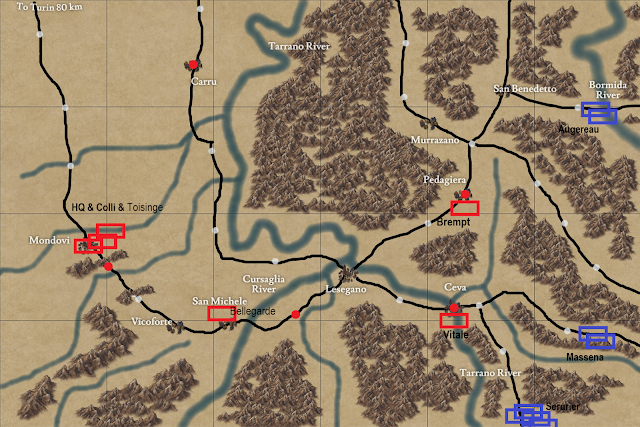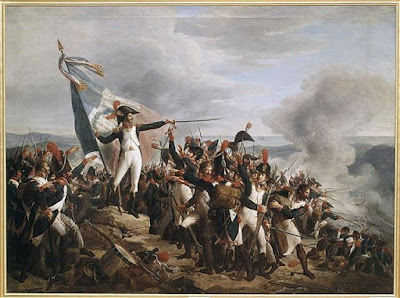The Mondovi Operation
Italy
1796-97 The War of the First Coalition
The Mondovi Operation: A Black
Powder Campaign Scenario:
Background
In March 1796
Napoleon Bonaparte took command of Revolutionary France’s Army of Italy.
In April 1796
the French broke out of the enclave they were holding on the Italian riviera
and seized the central position between the allied armies of Piedmont and
Austria.
This scenario
covers the second week of the campaign. It includes the actions fought at Ceva,
Pedagiera, the Cursaglia and outside Mondovi, which resulted in Piedmont suing
for peace.
Essentially,
faced with two-to-one odds, the Piedmontese commander-in-chief General Colli
conducts a fighting withdrawal via successive defensive positions. He is trying
to keep his army intact and buy time for his Austrian ally, Beaulieu, to
regroup at Acqui and return to the fray by attacking the French right flank. On
the 16th, the leading French division under Augereau is repulsed at Pedagiera.
This is one end of a strong fortified line, the other being at Ceva on the
Tanaro river. Napoleon moves Masséna’s division to Mombarcaro to keep Colli cut
off from Beaulieu. He brings up Sérurier’s division and prepares a major
assault on Ceva, while probing round the flank.
However, Colli
slips away overnight and falls back to the line of the Cursaglia. This is a
river with few crossing points and a steep west bank. Here too the French are
initially repulsed on the 19th.
Again the
French prepare a new assault, again they probe past the flank, and again Colli
tries to preempt them by falling back. This time, however, some of his troops
are too tardy and are caught by the French attackers. Consequently they reach
their new position outside Mondovi in disorder. The Sardinian army fights
bravely but is finally routed, and the King sues for peace with France. Piedmont
is knocked out of the war.
What will
happen in this re-enactment?
Victory & Defeat:
Victory
revolves around how long the Sardinians can delay the French while keeping
their army in being. They must hold Ceva and the Pedagiera redoubt at the end
of 18 April; San Michele at the end of 21 April; Carrù and the ridge by Mondovi
at midnight on 22 April. If a position is lost and they then retake it, it is
considered held. They earn:
1 VP for each
Objective location they hold at the end of its “Deny Until” turn;
1 VP if they
still have 5 or more non-Spent units at game end. The Artillery counts as a
unit.
Sardinian
Victory: Sardinians have 5+ VP.
Draw:
Sardinians have 4 VP.
French Victory:
Sardinians have 3 or fewer VP.
6 days – 16-22
April (18 map move periods)
Objective
|
Hold Until
|
Ceva
|
Midnight 18 April
|
Pedagiera
|
Midnight 18 April
|
San Michele
|
Midnight 21 April
|
Carrù
|
Midnight 21 April
|
Mondovi Ridge
|
Midnight 22 April
|
Victory Conditions
The
protagonists earn 1 Victory Point (VP) for each Objective location they hold at
the end of its “Deny Until” turn;
1 VP if they
still have 5 or more formations in being at game end. Artillery counts as a formation. All
other formations are brigade sized units.
Sardinian
Victory: Sardinians have 5+ VP.
Draw:
Sardinians have 4 VP.
French Victory:
Sardinians have 3 or fewer VP.
Campaign
Length
6 days – 16-22 April 1796 or18 periods for the
purpose of map movement (see map movement rules annex A).
Order of Battle & Initial Dispositions
Battalions
& batteries are units; regiments, brigades and divisions are formations.
Unless stated otherwise all units are standard size. General and brigade
commanders’ staff ratings (SR) are listed.
Piedmontese Army
Commander in
Chief: General Michelangelo Colli-Marchi (SR7)
1st Right
Wing Div, Col Marquis
de Toisinge
4 standard
infantry bns & 1 x volunteer light infantry bn
Cavalry
Reserve – 4 x small regts
of hussars; 2 x small regiments of dragoons; 1 small regt of uhlans (under direct
command of Colli)
1st Left
Wing Division: Col
Baron Brempt
8 x standard infantry
bns in prepared positions at Pedagiera
2nd Left
Wing Division Brigadier
Francesco Vitale
8 x standard
infantry bns
2 x Grenadier bns
1 volunteer
light infantry bn in prepared positions at Ceva
2nd Right Wing Division Col Marquis de
Bellegarde at San Michele
8 infantry bns
2 Grenadier bns
3 Light infantry bns
1 x battery of foot artillery
French Army
Commander in Chief:
Napoléon Bonaparte (SR10)1 x battery of horse artillery under direct command
enters on 18 April from Millesimo
General
Charles-Pierre-François Augereau (SR 9)
Division
Augereau enters on morning of 16 April east of Pedagiera
Brigade Beyrand (SR 8)
4th Light
Demi-Brigade 3 x small bns
29th Light
Demi-Brigade 3 x small bns
Brigade Victor (SR8) enters
on morning of 18 April from Millesimo
4th Line
Demi-Brigade 3 x bns
18th Line
Demi-Brigade 3 x bns
General
André Masséna (SR9)
Division
Masséna enter morning
of 16 April at Bormida bridge
Brigade
Dommartin
11th Light
Demi-Brigade 3 x small bns
27th Light
Demi-Brigade 3 x small bns
Brigade Joubert
51st Line
Demi-Brigade 3 x bns
55th Line
Demi-Brigade 3 x bns
General Jean-Mathieu-Philibert Sérurier
Division
Sérurier enter on 16
April from direction Garessio
Brigade Guieu (SR8)
39th Line
Demi-Brigade 3 x bns
69th Line
Demi-Brigade 3 x bns
Brigade
Fiorella (SR8)
14th Line
Demi-Brigade 3 x bns
56th Line
Demi-Brigade 3 x bns
General Stengel
1st Cavalry
Division enters on
morning of 19 April from Millesimo
2 Regiments of
Hussars
2 Regiments of
Chassuers a Cheval
2 Regiments of
Dragoons
Scenario
& Special Rules
The Tanaro and Cursaglia Rivers were swollen
and difficult to cross. Nonetheless, a unit that starts its turn adjacent to a
River and throws a 4+ ON A D6 may cross the river using one move to do so. It
ends its movement disordered on a throw of 1 on a D6.
Because of the
exceptional energy and endurance shown by the French troops, as well as the
quality of many of their junior leaders, French infantry units are all rated Elite 4 +
Sardinian
grenadier units are rated as per Austrian Grenadiers and their light infantry
as Grenzers but wavering.
This scenario
nicely illustrates the challenges, and the risks, of a fighting withdrawal,
which is notoriously one of the most difficult operations in war.
The length of
front and the French superior numbers mean that each Sardinian position will
eventually be outflanked or overwhelmed. The trick for the Sardinian commander
is to decide when it is time to fall back to the next. He will also want to
maintain a reserve to respond to French breakthroughs, and to counter-attack as
Colli did.
The time
pressure on the French means they will probably have to attempt hasty assaults,
just as happened historically at Ceva and at the Cursaglia. These may be
(historically) repulsed; but they may get lucky, or they may disrupt and pin
the Sardinians enough to hinder their withdrawal. Meanwhile they should
constantly probe round the Sardinian flanks.
French move
first



Comments
Post a Comment